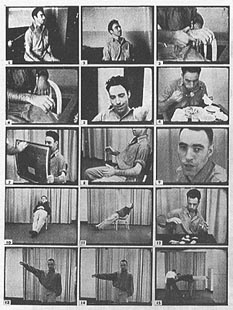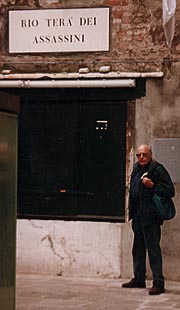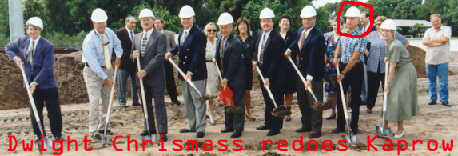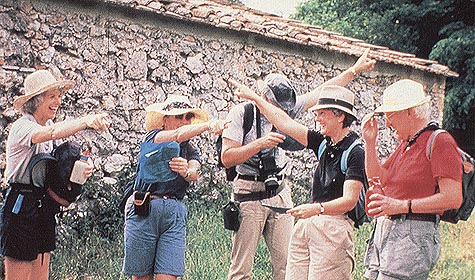James Hugunin:
What has been some
of the most profound changes that you've noticed since we last chatted over
twenty years ago?
Dwight Chrissmass:
Besides losing most of my hair [runs a hand through non-existent hair] and
nursing an enlarged prostate? Oh, yes! And besides being mistaken for a Mafia
hit man while touring Italy?
J. H.: Yeah
[laughing].
D. C.: Then I'd
say the profound connectedness and relatedness of things these days that has
us awash in a plurality of ideas, styles, and new 'spaces' to exist in. Everything
is analogous to everything and nothing is ever really new. By gar! That's
what I was trying to say in my "Re-Doing Kaprow Series" [1991 - 94] where
I was systematically restaging all of Allan Kaprow's best-known "Happenings"
[see image above].
J. H.: Why do you
pronounce "Doing" like "Boing" but with a "D"?
D. C.: By gar, what
a dif one little old phoneme can make, huh? Well, Kaprow's peformances were,
in my Polish mind, all about control. Very macho stuff, getting all these
people to do what he wanted them to do. Very modernist, by gar! Had something
to do with asserting the old male doing -- er -- dong! Get it? [Deep
laugh.]
J. H.: But back
to my initial question about this profound interconnectedness you mentioned.
D. C.: Yeah, that
concept can be summed up in two quotes [holds up two fingers] I've pasted
on my loft's Zone V colored wall [middle-gray on Ansel Adams's Photographic
Zone System]. The first is by noted ecologist Barry Commoner: "Everything
is connected to everything else," and the second is by art critic Hal
Foster: "Postmodern art occurs in alternative spaces."
At first they may seem antithetical statements, Commoner's being inclusive,
while Foster's is exclusive. But if you think that (what I believe anyway) is
occurring is interconnectivity on an electronic level (the Internet, yes?) that
mimics the interrelatedness of everything as one large ecosystem -- you know,
where a butterfly flapping its wings in a rain forest, it is said, can effect
things thousands of miles away -- then alternative spaces for postmodernist
art are everywhere. For instance, I've found the postal system to be a space
I can inhabit with my l'art postale -- it sounds more aesthetic in French,
no?
J. H.: Oui, oui.
. . . Work such as your Hew:Yew:: ? piece which I've used in this
issue, right?
D. C.: Yeah. I also
think the Web is one of the most exciting of alternative spaces, an invaluable
resource for the dissemination of, and perfect site for, aesthetic production
[smug look on his face]. Why I permitted you to reproduce one of my postale
pieces. By the way, more analogies here. Chicago's MCA [Museum of Contemporary
Art] before it entered the big leagues was to the Chicago Art Institute
as the Web-as-exhibition-space is now to the MCA.
J. H.: But some
might say viewing artwork on the Net is at best an interesting surrogate for
the real thing, even further removed from the auspicious original than print
reproduction. What say?
D. C.: Well . .
. [scratches his nose] I think as more artworks are done with the Web
in mind as the alternative space most fit for its, how you say, venue?
Well, then there will be a closer fit between type of artwork and space,
between artwork and viewing context, yes? Postmodern art would seem most postmodern
as art most fit for the Web.
J.H.: Already some
artists are doing work that is exclusively for the Internet or CD-ROMs.
D. C.: Of
course, but let me continue. I see those who look down their nose at the Net
as a potential site for artwork -- no matter how much lip service they give
to being good 'posties' [postmodernists] by showing cutting edge work
in their establishment galleries and museums -- are still mind-locked into the
modernist paradigm. I think they feel threatened by it the way large corporations
feel about the ecology movement -- its subversive of the status quo,
yes?
J.H.: Well, it hasn't
achieved yet the 'cultural capital' (to borrow a phrase from Pierre Bourdieu)
that has accrued to the gallery or museum. But increasing those more traditional
institutions are scanning their archives, putting up websites, commissioning
works for the web, doing CD-ROMs. Doesn't that obviate your argument?
D. C.: Oby what?
[Mops his face, it's hot in late August and in keeping with Dwight's frugality
his studio is not air-conditioned.] My English is still never so good
you know.
J. H.: Ah, I meant
does that not counter your argument?
D. C.: Ho! Good
observation, but no cigarillo -- er -- cigar. It shows those institutions
wittingly, or unwittingly, trying to tame the new technology -- I think you
critics use the word 'incorporation' or 'co-optation' or something like that.
But this technology is heaps unruly, a 'rhizome' not so easily pruned into
submission like the branchly tree. I'm right, huh? [Moves his Queen near
my King] Checkmate, yes? [Look of triumph on his face, meaning he thinks he's
won the game and our debate.]
J. H.: Let's see
what our readers/viewers have to say on this topic, Dwight. They can use our
BBS, e-mail, and guest book to comment. As you just hinted, part of the democratic
possibilities of this new technology, Dwight!
D. C.: Ach, hoisted
on my own pétard! . . . But . . . at least I've checkmated you, my friend!



